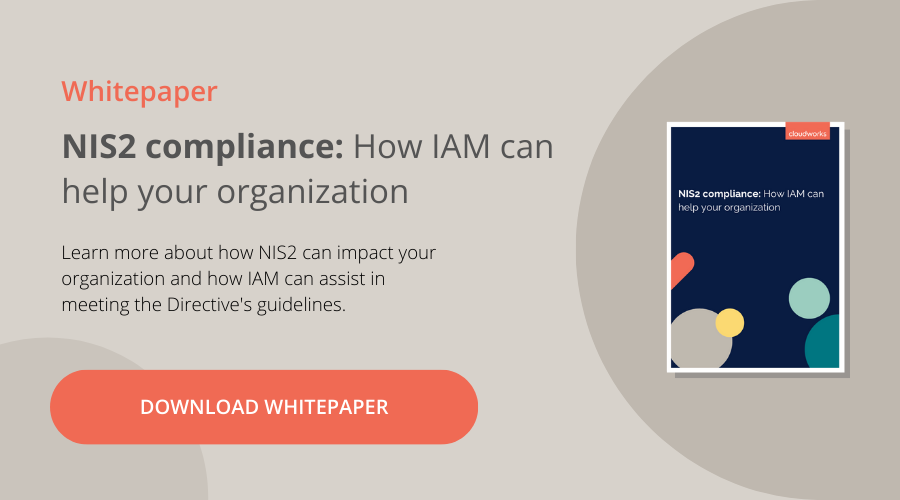5 measures to take to prepare for NIS2 with Identity and Access Management
With the NIS2 Directive on its way, new and stricter requirements are being introduced for organizations regarding data security and continuous reporting. Fortunately, Identity and Access Management can help to meet several of these requirements.
What is NIS2?
NIS2 is an updated version of the EU's first cybersecurity directive, NIS, with increased focus on:
Strengthening organizations' resilience against cyberattacks
Promoting information sharing
Ensuring uniform security standards
The Directive introduces stricter security requirements for organizations in the EU and those providing services in EU countries.
One of the key points in NIS2 is that companies must:
Have tailored control over who has access to which data
Proactively identify and respond to abnormal behavior or potential security breaches
Be able to present detailed reports on data access and activity
When does NIS2 come into effect?
NIS2 is an EU directive, which means it needs to be adapted and implemented into the national legislation of each EU country. The Directive came into effect in January 2023 and must be implemented in the countries by the autumn of 2024 at the latest. This means that the requirements may vary from country to country. However, there are a number of general guidelines in NIS2 that your organization should already be preparing for now.

What is IAM and how can it help your organization get ready for NIS2?
Identity and Access Management (IAM) is about managing and monitoring who has access to what. It involves continuous monitoring and control of access rights to ensure that they remain appropriate and secure. IAM can assist in authenticating and authorizing identities, managing access rights, and monitoring user activity, as well as generating reports on accesses and identities. These are all key aspects of NIS2.
1. Understand what NIS2 means for your organization
The first important step is to understand exactly how the NIS2 Directive will affect your organization. The Directive expands its scope to include more sectors and applies to all organizations that provide services within the EU's borders. Moreover, the Directive encompasses the entire supply chain.
Even if your organization is not subjected to NIS2, it represents best practice. The basic guidelines from the Directive will benefit any organization, regardless of whether it is a requirement.
NIS2 is designed with the purpose of equipping organizations to better withstand cyberattacks and ensure that your organization can minimize costs if the worst should happen.
2. Strengthen security with Privileged Access Management (PAM)
Privileged Access Management, also known as PAM, plays a crucial role in relation to the NIS2 Directive. PAM is a part of the IAM umbrella and focuses on protecting access for users with extended rights - the so-called privileged users, who are often targets of cyberattacks due to their comprehensive access and control.
By using multi-factor authentication and real-time monitoring of privileged users' activities, PAM enhances your organization's ability to quickly detect and respond to suspicious behavior. A critical element in an effective PAM strategy is Zero Standing Privileges, which ensures that no persistent privileged access rights are associated with specific identities and accounts. This reduces the risk and potential impact of a cyberattack by limiting the access that attackers can obtain through a compromised user.

3. Invest in Identity Governance and Administration (IGA)
Identity Governance and Administration (IGA) is a central component of IAM and plays a crucial role in meeting the guidelines of the NIS2 Directive for robust management of digital identities. IGA includes important elements like Access Governance, Entitlement Governance, User Lifecycle Management, and Identity Provisioning, each of which plays a vital role in ensuring compliance and enhancing the security of your organization.
IGA ensures that user identities and access rights in the organization are properly managed throughout the user's lifecycle, and are decommissioned and removed when necessary.
Thus, IGA is important for managing all identities in your organization, as emphasized by NIS2.
4. Improve your organization's access management
NIS2 mandates that organizations maintain strict control over access to critical data and systems. Access Management strategies can help ensure just that. Access Management is a key component of IAM, as it ensures that only authorized identities have access to specific data or systems, and that this is supported by policies in accordance with the organization's security and compliance requirements.
Access Management can be integrated with IGA processes to ensure efficient management of accesses throughout the users' lifecycle.

5. Prioritize processes, policies, and people
For your organization to be ready for NIS2, it is important to focus on the core of cybersecurity: processes, policies, and people.
Review and refine the processes surrounding identity and access management to ensure they are effective and adaptable to a changing security landscape.
Establish robust IAM policies for uniform handling of identities and access rights.
Finally, it's important to remember that people are often the most crucial element in cybersecurity. Make sure to educate and train employees in security principles and the importance of IAM.
With a solid foundation established, the subsequent process of implementing and applying the correct IAM solution will become easier and more efficient.











